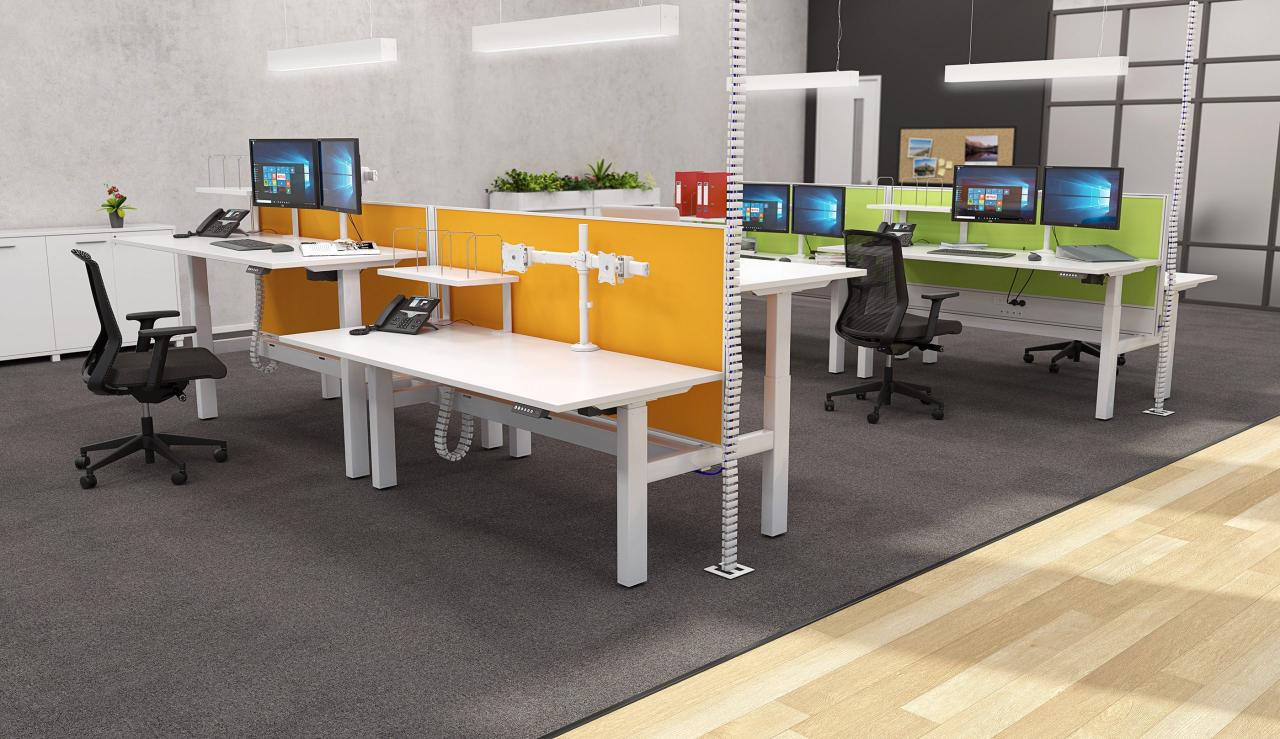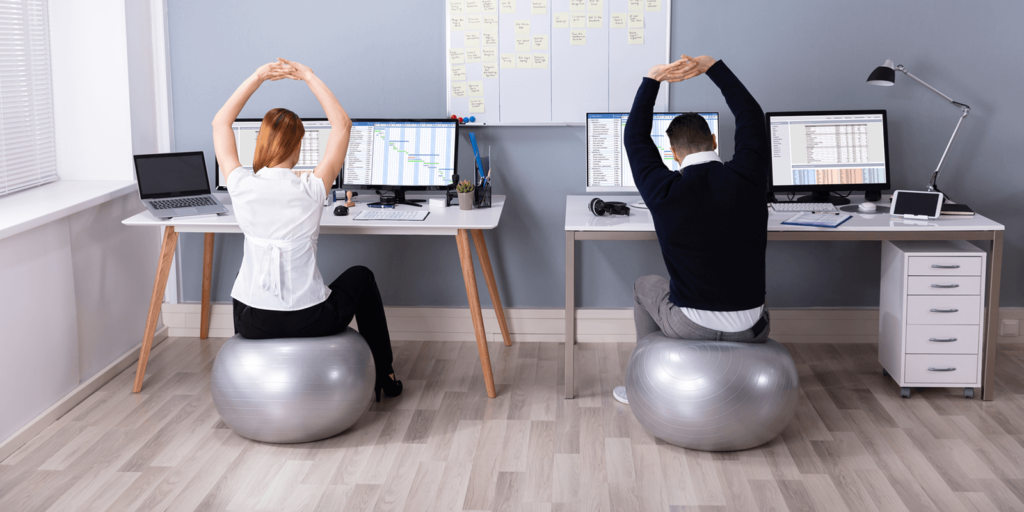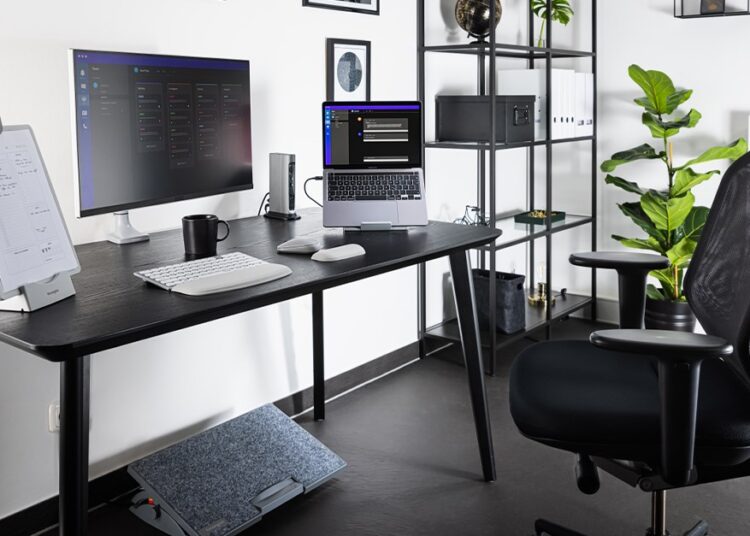The Imperative for Ergonomics

The heightened focus on ergonomics in the office is a response to several interconnected factors, highlighting its critical role in contemporary work environments.
A. Prevalence of Sedentary Work:
A. Increased Screen Time: The digital age has led to jobs predominantly involving long hours sitting at computers, increasing the risk of musculoskeletal disorders (MSDs) such as carpal tunnel syndrome, back pain, and neck strain.
B. Lack of Movement: Traditional office setups often discourage movement, leading to issues associated with prolonged sitting, including poor circulation, increased risk of chronic diseases, and reduced metabolic rate.
C. Remote Work Acceleration: The global shift to remote work has often meant employees using suboptimal home office setups, exacerbating ergonomic issues that were already present in traditional offices.
B. Rising Healthcare Costs and Productivity Losses:
A. Work-Related Injuries: MSDs are among the leading causes of workplace injuries and lost workdays, incurring significant costs in workers’ compensation claims, medical expenses, and reduced productivity.
B. Absenteeism and Presenteeism: Employees experiencing discomfort or pain are more likely to be absent from work (absenteeism) or, worse, present but unproductive due to pain (presenteeism). Both negatively impact an organization’s bottom line.
C. Employee Turnover: Chronic discomfort and poor working conditions contribute to employee dissatisfaction, leading to higher turnover rates and increased recruitment costs.
C. Legal and Regulatory Compliance:
A. Occupational Health and Safety Standards: Governments and regulatory bodies worldwide are increasingly implementing guidelines and regulations that mandate safe and healthy working conditions, including ergonomic considerations. Non-compliance can result in hefty fines and legal liabilities.
B. Duty of Care: Employers have a legal and ethical duty of care to provide a safe working environment for their employees. Ergonomic provisions fall directly under this umbrella.
D. Competitive Talent Landscape:
A. Attracting and Retaining Talent: In a highly competitive job market, companies offering supportive and health-conscious work environments are more attractive to top talent. Ergonomic provisions are seen as a tangible commitment to employee well-being.
B. Employee Expectations: Modern employees, particularly younger generations, are more aware of health and wellness issues and expect their employers to provide conditions that support their long-term health.
C. Brand Reputation: Companies known for prioritizing employee well-being, including ergonomics, build a strong brand reputation as responsible and desirable employers.
Core Principles of Ergonomic Office Design
Ergonomics in the office is not a one-size-fits-all solution; it’s about tailoring the environment to fit the individual. Several core principles guide the design and implementation of ergonomic solutions.
A. Neutral Posture Promotion
The primary goal is to support the body in a neutral, relaxed posture to minimize strain on muscles, tendons, and joints.
A. Sitting Posture:
A. Feet Flat on Floor: Or supported by a footrest if necessary. Knees should be at approximately a 90-degree angle.
B. Hips Higher Than Knees: Or at least level, promoting a slight forward tilt of the pelvis and maintaining the natural curve of the lower back.
C. Back Supported: The chair’s backrest should support the natural curve of the spine, especially the lumbar region.
D. Shoulders Relaxed: Shoulders should be down, not hunched.
E. Elbows at 90-120 Degrees: When typing, forearms should be parallel to the floor, with wrists straight.
B. Standing Posture:
A. Weight Evenly Distributed: Avoid leaning predominantly on one leg.
B. Slightly Bent Knees: Avoid locking knees.
C. Head and Neck Aligned: Head balanced directly over shoulders, not thrust forward.
C. Movement and Micro-breaks: Encouraging frequent changes in posture and short breaks to stretch or walk around, counteracting the effects of prolonged static postures.
B. Adjustability and Customization
Recognizing that every individual is different, ergonomic solutions prioritize adjustability to fit a wide range of body types and preferences.
A. Adjustable Seating: Chairs with multiple adjustment points (seat height, seat depth, backrest height and recline, armrest height and pivot) are fundamental.
B. Adjustable Desks: Sit-stand desks (either electric or manual) allow users to seamlessly alternate between sitting and standing throughout the day.
C. Adjustable Monitor Arms: Allow monitors to be positioned at the correct height and distance, reducing neck and eye strain.
D. Adjustable Peripherals: Ergonomic keyboards, mice, and other input devices that can be adapted to individual hand and wrist positions.
C. Proximity and Reach Zone Optimization
Arranging frequently used items within easy reach to minimize stretching and awkward postures.
A. Primary Reach Zone: Items used most often (keyboard, mouse, phone, pen) should be within easy reach without leaning or stretching.
B. Secondary Reach Zone: Items used less frequently (stapler, reference materials) should be within a comfortable reach, requiring only a slight lean.
C. Avoid Over-reaching: Positioning monitors and other equipment too far away forces a forward head posture and shoulder strain.
D. Lighting and Visual Comfort
Optimizing lighting to reduce eye strain, headaches, and visual fatigue.
A. Natural Light Maximization: Positioning workstations to benefit from natural light, reducing reliance on artificial lighting and supporting circadian rhythms.
B. Glare Reduction: Minimizing glare on screens from windows or overhead lights through proper monitor placement, anti-glare filters, and window treatments.
C. Appropriate Task Lighting: Providing adjustable task lights for specific activities, allowing users to control illumination levels.
D. Balanced Illumination: Ensuring consistent light levels across the workspace, avoiding extreme contrasts between brightly lit screens and dark backgrounds.
E. Reduction of Repetitive Strain
Designing tools and environments to minimize repetitive motions and sustained awkward postures.
A. Ergonomic Input Devices: Keyboards designed to promote natural hand and wrist positions (e.g., split keyboards, tented keyboards) and mice that reduce wrist deviation (e.g., vertical mice, trackball mice).
B. Force Reduction: Designing tools and interfaces that require minimal force to operate, reducing strain on fingers and hands.
C. Automating Repetitive Tasks: Utilizing software or macros to automate highly repetitive computer tasks.
Key Ergonomic Office Solutions Flourishing

The market is brimming with innovative solutions designed to meet the growing demand for ergonomic workplaces. These solutions cater to a wide range of needs and budgets.
A. Ergonomic Seating
The foundation of any ergonomic setup, a good chair provides crucial support.
A. Adjustable Office Chairs: High-quality chairs offer a multitude of adjustments:
A. Seat Height: Pneumatic lift to allow feet flat on the floor or a footrest.
B. Seat Depth: To ensure proper thigh support and prevent pressure on the back of the knees.
C. Backrest Recline and Tension: Allowing users to lean back and maintain spinal support, with adjustable resistance.
D. Lumbar Support: Adjustable support for the lower back’s natural curve.
E. Armrests: Height and pivot adjustable to support elbows at 90-120 degrees and relieve shoulder strain.
B. Saddle Chairs: Encourage an open hip angle and can promote a stronger core, reducing pressure on the lower back.
C. Active Seating:
A. Balance Balls/Stools: Promote core engagement and slight movement, but should be used in moderation and rotated with a traditional chair.
B. Kneeling Chairs: Distribute weight between knees and buttocks, opening the hip angle, but also best used for shorter durations.
B. Adjustable Workstations
Promoting movement and varied postures throughout the day.
A. Sit-Stand Desks (Standing Desks):
A. Electric Sit-Stand Desks: Offer smooth, quiet, and effortless transitions between sitting and standing heights with the push of a button, often with programmable memory settings.
B. Manual Sit-Stand Desks: Use gas springs or hand cranks for adjustment, more budget-friendly but less convenient.
C. Desktop Converters: Units that sit on top of an existing desk, allowing a monitor and keyboard to be raised for standing, a cost-effective option.
B. Treadmill Desks/Bike Desks: Integrate light exercise into the workday, allowing users to walk or cycle slowly while working. These promote constant, low-impact movement.
C. Modular Desking Systems: Allow for easy reconfiguration of workspaces to adapt to different team needs and work styles, supporting dynamic office environments.
C. Ergonomic Input Devices
Addressing strain in hands, wrists, and arms.
A. Ergonomic Keyboards:
A. Split Keyboards: Separate the keyboard into two halves, often with adjustable angles, to reduce ulnar deviation (wrist bending outwards).
B. Tented Keyboards: Keyboards that angle upwards in the middle, promoting a more natural handshake-like wrist posture.
C. Compact Keyboards: Reduce the distance to the mouse, minimizing shoulder reach.
B. Ergonomic Mice:
A. Vertical Mice: Position the hand in a natural handshake grip, reducing forearm pronation.
B. Trackball Mice: Allow cursor control with thumb or fingers, reducing overall arm movement.
C. Roller Mice: Placed in front of the keyboard, allowing for central cursor control with both hands, reducing reaching.
C. Touchpads and Stylus/Tablet Combinations: Alternative input methods that can reduce repetitive strain from traditional mouse usage.
D. Monitor Ergonomics
Optimizing visual comfort and neck posture.
A. Monitor Arms: Adjustable arms that clamp to the desk, allowing users to easily raise, lower, tilt, swivel, and rotate monitors to the perfect ergonomic height and distance. Dual monitor arms are common.
B. Monitor Risers: Simpler, static stands to raise a monitor, a more budget-friendly option.
C. Eye-Level Positioning: Top of the monitor screen should be at or slightly below eye level.
D. Arm’s Length Distance: Monitor should be approximately an arm’s length away, with text size adjusted for comfortable viewing.
E. Anti-Glare Filters: Reduce reflections and eye strain.
E. Accessories and Supports
Enhancing comfort and posture throughout the day.
A. Footrests: Essential for individuals whose feet don’t comfortably rest flat on the floor, promoting proper leg and back alignment. Often adjustable for angle and height.
B. Wrist Rests/Palm Rests: Used to support the wrist or palm during breaks from typing, but should not be used while typing as they can impede blood flow.
C. Document Holders: Positioned between the keyboard and monitor or to the side, to minimize neck twisting and eye movement when referring to physical documents.
D. Ergonomic Headsets: Lightweight, comfortable headsets for phone or video calls, reducing neck strain from cradling a phone.
E. Standing Mats: Cushioned mats for standing desks to reduce fatigue in feet and legs, improving comfort during standing periods.
Implementing Ergonomic Solutions
Successfully integrating ergonomic solutions into an office requires more than just purchasing equipment; it demands a comprehensive strategy.
A. Assessment and Planning
A. Ergonomic Assessments: Conduct individual assessments of workstations, either by certified ergonomists or trained in-house personnel, to identify specific risks and recommend tailored solutions.
B. Employee Feedback: Engage employees in the process through surveys and discussions to understand their needs and concerns, fostering buy-in.
C. Budget Allocation: Dedicate a specific budget for ergonomic equipment and, if necessary, professional ergonomic services.
B. Procurement and Implementation
A. Phased Approach: For larger organizations, consider implementing solutions in phases, starting with high-risk employees or specific departments.
B. Vendor Selection: Choose reputable ergonomic suppliers who offer high-quality, durable, and adjustable products with good warranties and support.
C. Installation and Setup: Ensure equipment is properly installed and adjusted for each individual. Don’t just provide the tools; show people how to use them correctly.
C. Training and Education
A. User Training: Provide comprehensive training to all employees on proper ergonomic setup, posture, and the importance of regular movement and micro-breaks.
B. Manager Training: Equip managers with the knowledge to identify potential ergonomic risks and support their team members in adopting healthy habits.
C. Resources and Guides: Provide easily accessible resources, such as online guides, videos, or laminated checklists, for self-assessment and adjustment.
D. Policy and Culture
A. Ergonomic Policy: Develop a clear company policy on ergonomics, outlining the organization’s commitment, available resources, and employee responsibilities.
B. Promote Movement Culture: Encourage and facilitate regular movement throughout the day through initiatives like walking meetings, designated stretch breaks, or active commuting.
C. Leadership Buy-in: Ensure leaders model healthy ergonomic practices and actively support ergonomic initiatives, setting a positive example.
D. Regular Review: Periodically review ergonomic policies, conduct follow-up assessments, and update equipment based on new research, technology, and employee feedback.
Challenges and Future Trajectories in Office Ergonomics
While significant progress has been made, the field of office ergonomics continues to evolve, addressing new challenges and leveraging emerging technologies.
A. Overcoming Challenges
A. Cost Justification: Demonstrating the direct ROI of ergonomic investments can be challenging for some organizations, despite long-term benefits in productivity and reduced healthcare costs.
B. Resistance to Change: Employees may be resistant to changing ingrained habits or uncomfortable with new equipment, requiring effective change management and training.
C. Maintaining Consistency in Hybrid Models: Ensuring ergonomic support for both in-office and home office setups presents a logistical challenge. Companies need to provide resources or stipends for remote employees.
D. Individual Differences: Designing solutions that truly accommodate the vast diversity in human body sizes, shapes, and specific needs remains a complex task.
E. “Set It and Forget It” Mentality: Users often set up ergonomic equipment once and then don’t make adjustments, even if their needs change. Ongoing education is crucial.
F. Greenwashing in Ergonomics: The market can be flooded with products marketed as “ergonomic” without scientific backing. Organizations need to be discerning.
B. Future Trajectories
A. Smart Ergonomics and IoT Integration:
A. Embedded Sensors: Chairs, desks, and keyboards with embedded sensors that monitor posture, movement, and pressure points, providing real-time feedback and personalized coaching to users via apps.
B. Automated Adjustments: AI-powered systems that learn individual preferences and automatically adjust desk height, monitor position, or chair settings throughout the day to encourage movement and maintain optimal posture.
C. Environmental Integration: Smart lighting that adjusts to reduce eye strain based on user focus or eye movement, and smart climate control that optimizes for individual thermal comfort zones.
B. Wearable Technology Integration:
A. Posture Trackers: Wearable devices that vibrate or provide alerts when posture deviates from optimal alignment.
B. Activity Monitors: Integration with fitness trackers to remind users to take breaks, stand, or move around.
C. Biometric Feedback Systems:
A. Stress Detection: Using facial recognition or heart rate variability to detect stress and suggest personalized interventions (e.g., a short meditation break, a change in lighting).
B. Eye Tracking: Monitoring eye movement and blink rate to detect visual fatigue and suggest breaks or adjustments to screen settings.
D. Gamification and Personal Coaching:
A. Interactive Apps: Gamified applications that encourage healthy ergonomic habits, set goals for movement, and provide rewards for maintaining good posture or taking breaks.
B. Virtual Ergonomists: AI-powered virtual coaches that can conduct remote ergonomic assessments through webcam analysis and provide personalized recommendations.
Conclusion
The flourishing landscape of ergonomic office solutions is a testament to a fundamental shift in how we view the workplace. It’s an acknowledgement that the human body is not merely a tool for labor but a complex system that thrives when supported by its environment. By strategically investing in adjustable furniture, smart technologies, and a culture that prioritizes movement and well-being, organizations are not just preventing injuries; they are unlocking the full potential of their workforce. This evolution ensures that offices are no longer just places where work happens, but dynamic ecosystems where health, comfort, and peak performance converge, leading to a more engaged, productive, and ultimately, a much healthier future of work.








